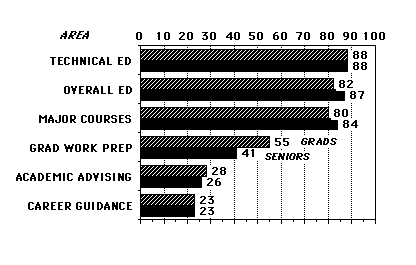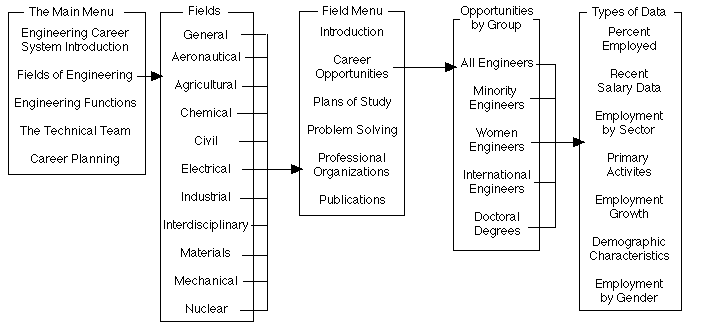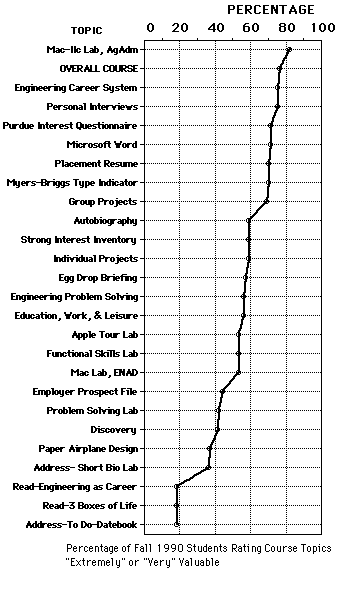

Figure 1: Percent of Engineering Seniors and Graduates who were "Satisfied" or "Very Satisfied" with Various Aspects of Their Undergraduate Program
The American Association of CollegesAAC, 1988 in their report "Unfinished Design" has stated that "academic advising is scandalously poor in higher education. The H&SS (Humanities & Social Sciences) advising of engineering students is worse than most." These findings are especially interesting in view of the following Accrediting Board for Engineering and Technology (ABET) guideline: "The engineering faculty must assume the responsibility of assuring that the students receive proper curricular and career advising." (ABET, 1989)
Meanwhile a computer and information revolution is taking place in engineering education.
Rapid changes in interactive computer technologies are especially evident in undergraduate
engineering programs. A parallel high-technology revolution is taking place in computer-assisted
career guidance systems (Maze, 1987) and in career-oriented video technology systems.
As a result, there is a proliferation of increasingly high quality educational and career development
materials that are available to assist in improving the academic advising, career development,
and life planning of engineering students. Engineering education is in a particularly good position
to take advantage of these developments due to its extensive involvement in the wide variety of
emerging technologies including personal computer workstations, interactive video-disc systems,
hypertext and hypermedia technologies, knowledge based expert systems and artificial intelligence.
These developments indicate that the time has come to develop a personalized hypermedia system to
meet the critical need for quality academic and career guidance in engineering education.
The primary purpose of the Purdue Engineering Career Development Project has been to improve the quality of undergraduate academic and career guidance in undergraduate engineering education. This part of the project specifically explores the feasibility of using various emerging computer technologies in engineering career guidance. An exploratory program called the Engineering Career System has been developed which helps engage students with career exploration by providing them with information about different engineering disciplines, as well as providing experience with the specific nature of problem solving in those disciplines. At the present time, this software is used primarily in Engineering 195C, an undergraduate engineering career oriented course designed to provide individualized academic and career counseling.
When the software development began for the Engineering Career System, Macintosh II computers from Apple appeared to be a friendly, flexible and interactive system capable of providing individualized academic advising within personalized counseling services. One of themost attractive elements of the Mac II was the HyperCard program which is distributed free with all Macintosh computers. HyperCard files are designed around the basic metaphor of a "stack" of modifiable index cards which can contain combinations of integrated text, sound, and pictures (including graphics) with a minimum effort due to the HyperCard programming language called "HyperTalk".
James Wilkinson, Director of the Harvard-Danforth Center for Teaching and Learning says that "interactive media are 'good with students who come in having different levels of knowledge, because it means you can give them a tool they can customize.' Software such as HyperCard, which can highlight key words and enable program authors to create 'a series of footnotes nested within each other,' allows the learners to 'look as far into the highlighted concepts as they want to,' Wilkinson says. 'And it's infinitely patient--it doesn't laugh at you,' a fact helpful to shy or inhibited students." (Lamber, 1990)
Using HyperCard has made the Engineering Career System easy to modify for use by other disciplines, and in various organizational and institutional settings. HyperCard on the Mac II was also advantageous because an application developed in HyperCard is portable to other computer systems. For example, it will be possible to port the Engineering Career System, and adapt it to an IBM Personal Computer, Next or Sun workstation. The long range goal is to interface academic and career guidance in other engineering and computer environments that will enhance and strengthen the exchange of information and methodology regarding engineering careers in particular, as well as careers in general.
Figure 2 provides a map of the Engineering Career System. Appendix A shows an example of an original HyperCard. The stacks included sample menus, sub-menus, employment salary data, plans of study, and semester courses which have been developed for each engineering discipline. Over 20,000 cards, have been developed so far, and more are under development. At the present time, the total system requires over five (5) megabytes of storage.

Figure 2: Map of Engineering Career System Menu Organization
Students can browse through the stacks easily by pressing appropriate buttons. There is also on-line instruction which help students learn how to use the system. To eliminate confusion, the buttons are designed to be self-explanatory. The advantage of using HyperCard is that each student is able to read and browse through materials which are of interest to them. Because the software is extremely flexible, there is no prescribed sequence which has to be followed. This flexibility is especially important in encouraging academic and career exploration.
One of the goals of this project is to enable each student to design their own
academic plan of study and career plan for their future. For this purpose,
information about possible plans of study and future outlooks of the great
diversity within the engineering disciplines are made available.
Through use of this software, the students become better educated in making
decisions about the possible alternatives, which include a choice of subdisciplines.
The course was very helpful, and it provided me with a lot of information
that will help me make a career decision.
During the spring semester of 1990, this class met and participated in the following activities:
You learn to use the Macs, learn a lot about yourself, and you learn about each
type of Engineering.
The problem-solving sessions included theoretical considerations on the part of the students, as well as hands-on experience. The hands-on experiences included an egg-drop contest and a paper airplane design competition. The egg-drop contest involved teams of two or three in which prototypes were designed and built with limited furnished supplies (rubber bands, string, masking tape, sticks, nylon bags, and poster boards) were distributed by Jane Cass, a loaned IBM executive engineer, who orchestrated the whole contest. The final test consisted of dropping the eggs from a four-story garage to a computer image target. Only one of nine teams passed the final test and was suitably awarded with emblemed plastic sports bottles. The airplane design activity included the organization of production systems for paper airplanes in which three organizational structures were used: laissez-faire, democratic, and authoritarian team (the democratic system won).
The third problem solving activity was the most analytical. During this activity, students were taught to use the engineering method to solve problems. This problem-solving session was conducted in the Macintosh lab and lasted one fifty-minute class period. The problems used were taken from Engineering as a Career, (Smith, Butler & LeBold, 1983) which were subsequently entered into HyperCard. Sample problems covered general, electrical, civil, mechanical, aeronautical, nuclear and industrial engineering. Each problem that the students solved had to have five steps: The problem description, the preliminary analysis, statement of problem, problem solution, solution check and interpretation of the problem. A sample problem is displayed in Appendix B (not available in this page).
It helped me to know myself better, and even though I am still undecided
on my career, etc., I think it helped me in something important. It also introduced me to
the Engineering Method and motivated me to investigate it.
To provide evaluation of the course, a comprehensive evaluation program has been developed. The 250 item survey is administered at the end of the course for summative evaluation and formative survey forms are used during the course to provide "on the spot" insight into special elements. Figure 3 provides some of the summative evaluative data collected in the fall of 1990 in the Engineering Career Development Course. It should be noted that the Mac IIc Lab, the overall course, the personal interviews, the Engineering Career System, the Microsoft Word exercise, and The Purdue Interest Questionnaire were rated the most valuable, whereas the traditional reading assignments were rated the least valuable activities during the course.

Figure 3: Percentage of Fall 1990 Students Rating Course Topics "Extremely" or "Very" Valuable
The Engineering Career System is good. It gave us a chance to research anything
we wanted. I was unfamiliar with a Macintosh- Now I can sit down and know what I'm doing.
HyperCard in a Macintosh environment will continue to be the primary vehicle that is used to provide interactive guidance services. These will include information, participation and problem-solving. Our intermediate goal will be to develop an interactive video system that will utilize more extensive hypermedia to provide students with even more in-depth educational, career and personal development information. Our long range goal will be to provide career system(s) that will provide telecommunications access in formats that are not hardware or software bound.